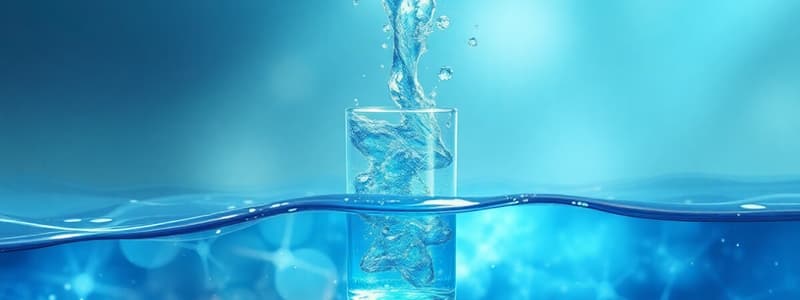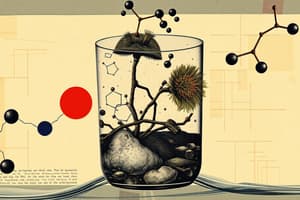Podcast
Questions and Answers
What property of water allows it to be an effective solvent?
What property of water allows it to be an effective solvent?
- Dipolar nature (correct)
- High specific heat capacity
- Low density in solid form
- High boiling point
Oxygen is less electronegative than hydrogen in a water molecule.
Oxygen is less electronegative than hydrogen in a water molecule.
False (B)
What type of bond forms between the oxygen and hydrogen atoms within a water molecule?
What type of bond forms between the oxygen and hydrogen atoms within a water molecule?
Covalent bond
Water is known as the _____ solvent because it can dissolve many types of substances.
Water is known as the _____ solvent because it can dissolve many types of substances.
Match the following properties of water with their descriptions:
Match the following properties of water with their descriptions:
What role does water play in cellular compartments?
What role does water play in cellular compartments?
Water cannot separate charged molecules.
Water cannot separate charged molecules.
Define the role of water as a universal solvent.
Define the role of water as a universal solvent.
Water plays a role in __________ by dissipating heat.
Water plays a role in __________ by dissipating heat.
Match the following properties of water with their functions:
Match the following properties of water with their functions:
Which of the following is NOT a function of water?
Which of the following is NOT a function of water?
Water has no role in transporting compounds in the blood.
Water has no role in transporting compounds in the blood.
What makes water a good solvent for many substances?
What makes water a good solvent for many substances?
What is the term for substances that do not interact well with water?
What is the term for substances that do not interact well with water?
The cations in ionic substances are attracted to the positive ends of water molecules.
The cations in ionic substances are attracted to the positive ends of water molecules.
What determines the solubility of a substance in a solvent?
What determines the solubility of a substance in a solvent?
A solution is a homogenous mixture of a _______ and a _______.
A solution is a homogenous mixture of a _______ and a _______.
Match the types of solutions with their examples:
Match the types of solutions with their examples:
Which of the following factors affects the speed of dissolving?
Which of the following factors affects the speed of dissolving?
All ionic substances dissolve equally well in water.
All ionic substances dissolve equally well in water.
Define amphiphilic substances.
Define amphiphilic substances.
How is weight percentage (w/w) calculated?
How is weight percentage (w/w) calculated?
An acid can accept hydrogen ions.
An acid can accept hydrogen ions.
What does molarity (M) represent in a solution?
What does molarity (M) represent in a solution?
A 5% NaCl solution contains ______ g of NaCl in 100 mL of solution.
A 5% NaCl solution contains ______ g of NaCl in 100 mL of solution.
Match the following solutions with their components:
Match the following solutions with their components:
What is the correct formula for Weight:Volume percentage (w/v)?
What is the correct formula for Weight:Volume percentage (w/v)?
An amphoteric substance can only act as an acid.
An amphoteric substance can only act as an acid.
Explain what happens when an acid ionizes.
Explain what happens when an acid ionizes.
What is the conjugate base of acetic acid?
What is the conjugate base of acetic acid?
Strong acids partially ionize in water.
Strong acids partially ionize in water.
Define pH.
Define pH.
Bicarbonate (HCO3-) is the conjugate base of ___________ acid.
Bicarbonate (HCO3-) is the conjugate base of ___________ acid.
Match the following acids with their conjugate bases:
Match the following acids with their conjugate bases:
How does the pH in the blood generally range?
How does the pH in the blood generally range?
Buffers are solutions that stabilize pH by combining weak acids and strong bases.
Buffers are solutions that stabilize pH by combining weak acids and strong bases.
What is the effect of adding an acid or base to a buffer system?
What is the effect of adding an acid or base to a buffer system?
Flashcards
Water's role as a solvent
Water's role as a solvent
Water dissolves many substances due to its dipolar structure.
Dipolar molecule
Dipolar molecule
A molecule with a positive and negative end, like water.
Hydrogen bond
Hydrogen bond
An attraction between a slightly positive hydrogen atom and a slightly negative atom of another molecule (especially oxygen, nitrogen, or fluorine).
Why is water important for dissolving substances?
Why is water important for dissolving substances?
Signup and view all the flashcards
Electronegativity in water
Electronegativity in water
Signup and view all the flashcards
Water structure and solubility
Water structure and solubility
Signup and view all the flashcards
Water as a universal solvent
Water as a universal solvent
Signup and view all the flashcards
What water dissolves
What water dissolves
Signup and view all the flashcards
Water's role in heat dissipation
Water's role in heat dissipation
Signup and view all the flashcards
Water's role in cellular compartments
Water's role in cellular compartments
Signup and view all the flashcards
Water's role in chemical reactions
Water's role in chemical reactions
Signup and view all the flashcards
Biological Importance of Water
Biological Importance of Water
Signup and view all the flashcards
Ionic substance solubility
Ionic substance solubility
Signup and view all the flashcards
Hydrophilic
Hydrophilic
Signup and view all the flashcards
Hydrophobic
Hydrophobic
Signup and view all the flashcards
Solution
Solution
Signup and view all the flashcards
Solvent
Solvent
Signup and view all the flashcards
Solute
Solute
Signup and view all the flashcards
Solubility
Solubility
Signup and view all the flashcards
Weight Percentage (w/w)
Weight Percentage (w/w)
Signup and view all the flashcards
Volume Percentage (v/v)
Volume Percentage (v/v)
Signup and view all the flashcards
Weight-Volume Percentage (w/v)
Weight-Volume Percentage (w/v)
Signup and view all the flashcards
Molarity (M)
Molarity (M)
Signup and view all the flashcards
Acid
Acid
Signup and view all the flashcards
Base
Base
Signup and view all the flashcards
Amphoteric Substance
Amphoteric Substance
Signup and view all the flashcards
Acid Ionization
Acid Ionization
Signup and view all the flashcards
Conjugate Base
Conjugate Base
Signup and view all the flashcards
Acetate
Acetate
Signup and view all the flashcards
Citrate
Citrate
Signup and view all the flashcards
Strong Acid
Strong Acid
Signup and view all the flashcards
Weak Acid
Weak Acid
Signup and view all the flashcards
pH
pH
Signup and view all the flashcards
Buffer System
Buffer System
Signup and view all the flashcards
Importance of Buffers
Importance of Buffers
Signup and view all the flashcards
Study Notes
Water, Acids-Bases, and Buffer Systems
- Learning Objectives:
- Recognize water structure
- Relate water structure to solubility
- Calculate solution concentrations
- Define acids and bases
- Describe buffers
Water
-
Water's properties are crucial for understanding biological molecules' interactions.
-
Water structure is important.
Water Composition
-
Total body water (about 60% of body weight in adults)
- Intracellular fluid (ICF) ~ 40% of body weight
- Extracellular fluid (ECF) ~ 20% of body weight
- Plasma ~ 20% of ECF
- Interstitial fluid ~80% of ECF
-
Composition varies by age.
Water as a Universal Solvent
- Water is the solvent of life.
- Dissolves and transports compounds in blood.
- Moves molecules within and through cell compartments.
- Separates charged molecules.
- Dissipates heat (regulates temperature).
- Participates in chemical reactions.
Solubility
- Water's polarity is responsible for its role as a solvent.
- Water dissolves many substances making it "the universal solvent".
- Ionic substances dissolve in water due to the attraction of ions to water's charged ends.
- Cations (positive ions) are attracted to the negative ends of water molecules.
- Anions (negative ions) are attracted to the positive ends of water molecules.
- Polar molecules can interact with water (hydrophilic).
- Nonpolar molecules do not interact with water (hydrophobic).
- Amphipathic molecules have both a polar and a nonpolar region, exhibiting both hydrophilic and hydrophobic behaviors.
Solutions
- Homogenous mixture of two or more substances.
- Major component is the solvent
- Minor component(s) is the solute
- Types of solutions (gas in gas, Liquid in Liquid, solid in solid etc.)
- Examples (Air, Saltwater)
Factors Affecting Solubility
- Type of solute and solvent
- Temperature
- Pressure
- Common ion effect
Factors Affecting Dissolving Speed
- Temperature
- Particle size
- Mixing
Amount of Solute in a Solution
-
Weight Percentage (w/w)
- Weight of solute in 100g of solution
-
Volume Percentage (v/v)
- Volume of solute in 100 mL of solution
-
Weight/Volume Percentage (w/v)
- Weight of solute in 100 mL of solution
-
Molarity (M)
- Moles of solute in 1L of solution
Acid/Base
- Acid: releases hydrogen ions
- Base: accepts hydrogen ions
- Amphoteric: can do both
- Acid-base conjugates (acid and its conjugate base) reduce pH change
Buffer Systems
- Resist pH changes.
- Consist of weak acid and its conjugate base, or a weak base and its conjugate acid.
Regulation of Blood pH
- Blood pH values usually range between 7.35 and 7.45
- Bicarbonate buffer system is important
- Phosphate buffer plays a role
- Proteins also act as buffers
Studying That Suits You
Use AI to generate personalized quizzes and flashcards to suit your learning preferences.




